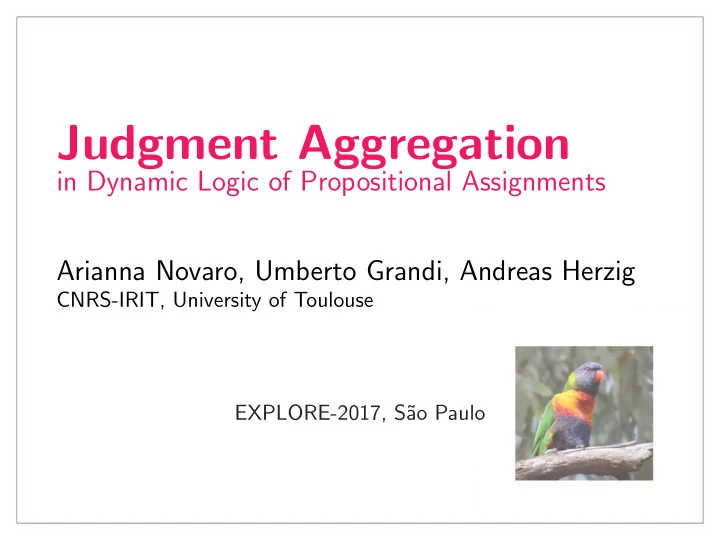

Judgment Aggregation in Dynamic Logic of Propositional Assignments Arianna Novaro, Umberto Grandi, Andreas Herzig CNRS-IRIT, University of Toulouse EXPLORE-2017, S˜ ao Paulo
Motivation Expressing a (social choice) framework in a formal language allows us to use automated reasoning tools, to find or to check results. Social choice functions ��� propositional logic → SAT-solvers Ranking sets of objects ��� propositional logic → SAT-solvers Judgment aggregation → JA logic → ? Judgment aggregation → DL-PA ��� propositional logic → SAT-solvers Papers by ˚ Agotnes, Endriss, Geist, van der Hoek, Lin, Tang, Wooldridge, . . . . 2
Talk outline 1 Recap of Judgment Aggregation (in Binary Aggregation) 2 Introduction to Dynamic Logic of Propositional Assignments 3 Translating aggregation rules, axioms and agenda safety 4 A last concluding slide 3
Binary Aggregation with Integrity Constraints We have a set of n agents and a set of m issues . An integrity constraint IC models logical dependencies among issues. Example of IC: “ ¬ ( Issue 1 ∧ Issue 2 ∧ Issue 3 ) ” i ’s individual ballot B i ∈ { 0 , 1 } m profile B = ( B 1 , . . . , B n ) aggregation rule F : Mod(IC) n → P ( { 0 , 1 } m ) \ {∅} 4
Dynamic Logic of Propositional Assignments Propositional Dynamic Logic models abstractly computer programs. Dynamic Logic of Propositional Assignments is an instance of PDL. The language of DL-PA has two types of expressions: ϕ ::= p | ⊤ | ⊥ | ¬ ϕ | ϕ ∨ ϕ | � π � ϕ formulas programs π ::= + p | − p | π ; π | π ∪ π | ϕ ? ◮ p ranges over a countable set of propositional variables ◮ possible to define the other connectives ( ∧ , → , . . . ) ◮ possible to define abbreviations for common programs ( p ? ; + q ) ∪ ( ¬ p ? ; − r ) ⇒ if p then + q else − r 5
How to translate JA into DL-PA? The basic ideas : ◮ A profile → a valuation over a set of variables ◮ An aggregation rule → a DL-PA program ◮ The outcome → a valuation over another set of variables profile 1 2 B 3 , 2 = { p 11 , p 12 , p 21 , . . . } , with p 11 and p 22 false Agent 1 0 1 majority Agent 2 1 0 a DL-PA program “maj” Agent 3 1 1 outcome Majority 1 1 O 2 = { p 1 , p 2 } , with both p 1 and p 2 true 6
Translating aggregation rules All aggregation rules are expressible as DL-PA programs. Proof idea. 1. Identify a profile B by a formula ϕ B 2. Build program π F ( B ) setting the outcome as in F ( B ) 3. Write a long sequence of “if ϕ B do π F ( B ) ” programs ⇒ Interested in more compact programs for aggregation rules. 7
Translating Slater rule Binary Aggregation Slater IC ( B ) = argmin H ( B, Maj ( B )) B | = IC DL-PA We prove that our translations are correct. 8
Translating axioms ◮ Single-profile axioms (unanimity, issue-neutrality, . . . ) • outcome linked to the structure of a single profile ⇒ we use propositional logic ◮ Multi-profile axioms ( independence, monotonicity, anonimity) • outcomes linked to structures of multiple profiles ⇒ we use DL-PA We prove also here that our translations are correct. 9
Translating monotonicity Binary Aggregation Let ( B − i , B ′ i ) = ( B 1 , . . . , B ′ i , . . . , B n ) for a profile B : For any issue j , agent i , profiles B = ( B 1 , . . . , B n ) and B ′ = ( B − i , B ′ i ) , ij = 1 then F ( B ) j = 1 implies F ( B ′ ) j = 1 . if b ij = 0 and b ′ DL-PA � i ∈N [+ p ij ; prof IC ( B n,m , O m ) ; f ( B n,m )] p j � � p j → � j ∈I 10
Translating agenda safety The structure of IC ensures classes of aggregation rules (defined by the axioms they satisfy) to return an outcome satisfying IC. ◮ median property ◮ k -median property ◮ simplified median property Turned as DL-PA formulas, using the concept of prime implicants . PI ( P, ϕ ) := [ flip 1 ( P )] � flip ≥ 0 ( P ϕ \ P ) �¬ ϕ ∧ [ flip ≥ 0 ( P ϕ \ P )] ϕ. 11
Conclusions We expressed many different aspects of Judgment Aggregation in Dynamic Logic of Propositional Assignments for the first time. ◮ Classical aggregation problems (e.g., winner determination) can be expressed in DL-PA. ◮ Checking whether rules satisfy axioms seems less promising than investigating further the agenda safety problem. ◮ Implementing examples of automated reasoning. ◮ Manipulation problem could also be translated. 12
Recommend
More recommend